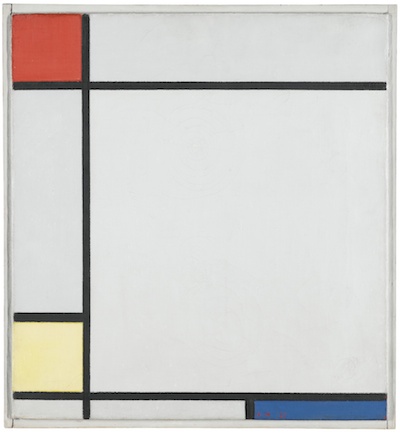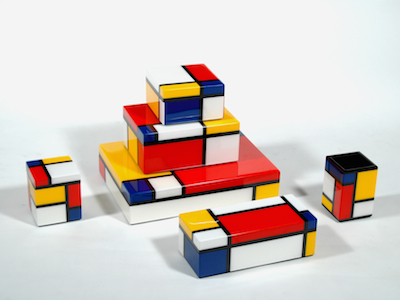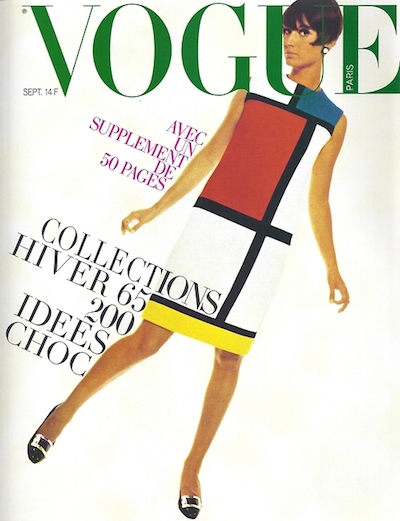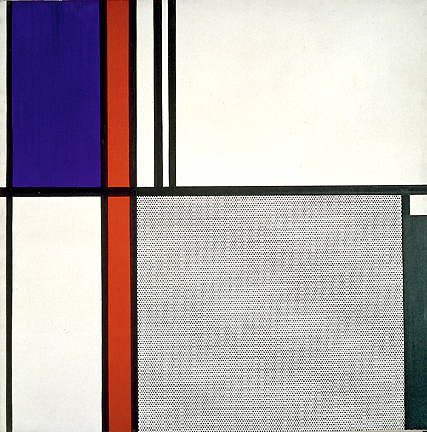One of the most fascinating relationships of our civilization is the magical bond between fashion and art. Possibly the greatest example of this bond is between the artist Piet Mondrian and designer Yves Saint Laurent .
Best known for geometric paintings with asymmetrical arrangements of rectangles in primary colors (blue, red, and yellow) as well as black, gray and white, Piet Mondrian was a very influential Dutch artist born in the 19th century. He was in a constant quest for purity and richness of content while using very simple colors and shapes.

COMPOSITION WITH RED, YELLOW AND BLUE Painted in 1927.

In today’s world Mondrian’s imagery has become omnipresent in consumer culture. Mondrian believed in the universal nature of art. The fact that his graphic style has been adopted worldwide and used on so many different media and everyday objects proves it.

Possibly, the most popular representation of this bond between fashion and art is the Yves Saint Laurent shift dress directly inspired by the composition “C, number 3” painted by Mondrian in 1935.
Imagine that you are back in 1965, for the launch of the autumn-winter collection of Saint Laurent. At this time, the young designer is struggling to get recognition. He is trying to emerge as an independent creator after having done his training at the Dior couture house. But none of his collections has met a real commercial success yet.

Yves was under pressure and was looking for inspiration. Sketching in his office he was trying to design a collection that would stand for something unique and help him express his creativity. He systematically tried to find the perfect line that will provide allure and freedom of movement to women. As he was drawing silhouettes, he had a spark of genius and imagined an audacious way to apply primary colors to a shift dress.
YSL always had a strong interest for art, and to foster this interest his mother gave him a special gift: a book about Mondrian. The Dutch abstract painter was one of his favorite artists and Yves always wanted to own an exhaustive collection of art masterpieces. A motivation that he will later on fulfill when building his private collection. He designed 10 dresses directly stirred from his abstract art muse. The seam was elegantly integrated in the structuring black frames to highlight the figure.
In our collective consciousness, those 10 dresses merged into a single one that we ended up calling THE “Mondrian dress”.
This is a turning point in Yves’s career as the press and the fashion enthusiasts all praised this collection. This was a complete switch for Saint Laurent and the designer explained he actually opened up for the first time. This officially became his first big commercial success that enabled him to found the Maison YSL with his partner Pierre Bergé.
Following this collection launch, YSL doubled its turnover, launched the ready-to-wear line and opened the “Rive Gauche” flagship store in Paris. The impact of this collection was so powerful that a lot of people even believe Mondrian’s compositions reached international fame thanks to the exposure his art got with the YSL collection.
This artistic inspiration enabled the development of one of the most successful haute couture houses. As a matter of fact, Mondrian’s style was already propagated in the fashion industry because while he was still alive Mondrian gave the authorization to all the international women’s magazines to use his compositions as decorative backdrops for fashion shoots.
In parallel, Mondrian was finding his footing in the art world, thereby giving the right environment to Saint Laurent and setting him for success. In 1964, when Pop artist Roy Lichtenstein used Mondrian’s work as an inspiration for his paintings, that style was already appropriated by the fashion world and had become a graphic design classic. One year later was the perfect time for the launch of Saint Laurent’s “Mondrian collection”.

NON-OBJECTIVE II painted in 1964
Saint Laurent was a firm believer that fashion had to tap into classics and history to dress the future. In this specific case, using Mondrian heritage made total sense, as the Dutch painter was a visionary that already set the mark for the future of minimalist art at the beginning of the 20th century, and this will pave the way for Neo-plasticism and Bahaus movements.
While Mondrian’s aesthetic influence is apparent in fashion, design, digital world, architecture, just to name a few, the varied interests shaping his memory have gone beyond it to an extraordinary degree. Today cakes, hotels and jigsaw puzzles also take inspiration from Mondrian. And the list goes on. The essence of his work is so intense and adaptable that it seems that Mondrian is a name that can be associated to anything.
“What once set this Dutch artist apart as marginal abstract artist is now a global trend.” ~Musart
The paradox is that when Mondrian initially released his compositions, he was labeled as conceptually difficult. In a period where the other “classic” Dutch painters were obsessed by an elaboration of fine details and realism, Piet boldly used a palette that was exclusively composed of primary colors, bordered by black straight lines. In this process he got rid of any unnecessary elements that would alter his goal of pure and simple aesthetics. Mondrian believed in a universal art that would unite all cultures in harmony. The harmony is depicted by the structure of his compositions that perfectly balance out the 3 primary colors.
Then a misunderstood pioneer, he became an iconic artist name that would later on become a brand totally adopted by pop culture. What once set this Dutch artist apart as marginal abstract artist is now a global trend, and we hope that his legacy will live on forever.
*****
Guest author: Our Musart vision is to make art more accessible and to beautify everyone’s life with culture.  Musart is a tribute to Mondrian’s work. Our logo is using the same primary colors as a homage to the “Man” and to witness the different cultures that are represented in our team.
Musart is a tribute to Mondrian’s work. Our logo is using the same primary colors as a homage to the “Man” and to witness the different cultures that are represented in our team.








Great article, Lori.
Thanks so much too!